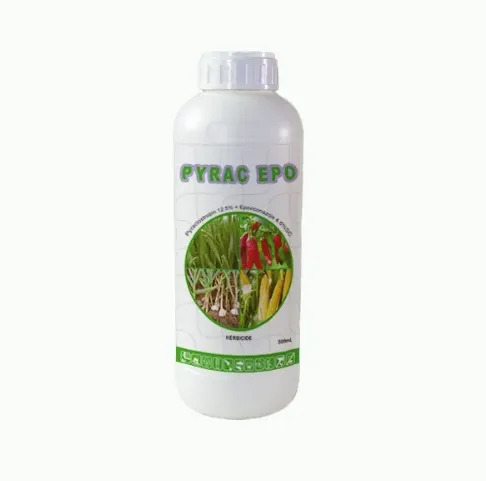
Jul . 21, 2025 13:59 Back to list
Protecting and effective cultivating Onion Crops with Fungicide
Fungal diseases can devastate onion crops, leading to significant yield losses and economic damage. Choosing the right fungicide for onion, understanding fungicide price factors, and utilizing advanced solutions like fluoxastrobin fungicide are essential for successful crop protection. This comprehensive guide explores these critical aspects, helping farmers make informed decisions to maximize their onion production while managing costs effectively.

Fungicide for Onion: Essential Protection Against Common Diseases
Onions are highly susceptible to fungal infections, which can affect foliage, bulbs, and overall yield. A targeted fungicide for onion is crucial to prevent diseases such as purple blotch, downy mildew, and botrytis leaf blight.
Key Benefits of Onion-Specific Fungicides:
✔ Disease Prevention: Protects against soil-borne and foliar pathogens.
✔ Improved Yield Quality: Reduces blemishes and rot in onion bulbs.
✔ Resistance Management: Rotating fungicides helps prevent pathogen resistance.
Common Onion Fungal Diseases and Control:
Purple Blotch (Alternaria porri): Causes purple lesions on leaves; controlled by triazole fungicides.
Downy Mildew (Peronospora destructor): Leads to yellow streaks and fuzzy growth; managed with systemic fungicides.
Botrytis Leaf Blight (Botrytis squamosa): Creates small white spots; treated with protective and curative sprays.
Best Application Practices:
Early Season: Begin sprays at the 3-4 leaf stage.
Regular Intervals: Reapply every 7-14 days during high humidity.
Coverage: Ensure thorough leaf and bulb coverage for maximum efficacy.
Understanding Fungicide Price: Factors Affecting Cost and Value
The fungicide price varies based on multiple factors, including active ingredients, formulation, and market demand. Farmers must balance cost with effectiveness to ensure economical disease management.
Key Factors Influencing Fungicide Prices:
✔ Active Ingredient: Premium chemicals like fluoxastrobin fungicide cost more but offer superior protection.
✔ Formulation Type: Liquid concentrates (SL) may be pricier than wettable powders (WP).
✔ Brand vs. Generic: Generic options reduce costs but may differ in adjuvants.
✔ Market Demand: Seasonal demand spikes (e.g., monsoon) can increase prices.
Tips to Optimize Fungicide Budget:
Preventative Use: Early applications reduce disease pressure and long-term costs.
Tank Mixing: Combining products can enhance efficacy and reduce sprays.
Bulk Purchasing: Buying in larger quantities often lowers per-unit costs.
3. Fluoxastrobin Fungicide: Advanced Protection for Onion Crops
Fluoxastrobin fungicide is a next-generation strobilurin fungicide known for its long-lasting protection and broad-spectrum activity against key onion pathogens.
Why Choose Fluoxastrobin?
✔ Dual Action: Works as both a protectant and curative treatment.
✔ Rainfastness: Adheres well to foliage, resisting wash-off.
✔ Residual Effect: Provides 14-21 days of protection per application.
✔ Resistance Management: Belongs to FRAC Group 11, best used in rotation.
Diseases Controlled by Fluoxastrobin:
Purple Blotch (Alternaria)
Downy Mildew
White Rot (Sclerotium cepivorum)
Stemphylium Leaf Blight
Application Guidelines:
Rate: 6-8 fl oz per acre (check label for specifics).
Timing: Apply at first sign of disease or preventatively in high-risk periods.
Mixing: Compatible with most insecticides and fertilizers.
Integrated Fungicide Strategies for Onion Farming
A well-planned fungicide program combines different chemistries to maximize protection while minimizing resistance risks.
Sample Onion Fungicide Rotation Program:
|
Growth Stage |
Recommended Fungicide |
Target Disease |
|
Early Vegetative |
Mancozeb + Copper |
General prevention |
|
Bulb Initiation |
Fluoxastrobin fungicide |
Purple blotch, downy mildew |
|
Bulb Development |
Azoxystrobin + Chlorothalonil |
Botrytis, Alternaria |
|
Pre-Harvest |
Tebuconazole |
Final disease suppression |
Additional Disease Management Tips:
Crop Rotation: Avoid planting onions in the same field consecutively.
Drip Irrigation: Reduces leaf wetness and fungal spread.
Field Sanitation: Remove crop debris to minimize spore carryover.
FAQs About Onion Fungicides
1. What is the best fungicide for onion purple blotch?
A combination of fluoxastrobin fungicide and chlorothalonil provides excellent control against purple blotch while managing resistance.
2. How does fungicide price vary between generic and branded products?
Generic fungicides can be 20-40% cheaper but may lack some formulation benefits. Always compare efficacy before choosing based solely on fungicide price.
3. Can fluoxastrobin fungicide be used in organic onion farming?
No, fluoxastrobin fungicide is a synthetic chemical. Organic growers should use copper-based or biocontrol fungicides.
4. How often should I apply fungicide for onion crops?
Typically every 7-14 days, depending on disease pressure and weather conditions.
5. What’s the most cost-effective way to manage onion fungal diseases?
Preventative sprays with multi-site fungicides (e.g., mancozeb) early in the season reduce the need for expensive systemic treatments later.
-
Tembotrione Mode of Action in Weed Control
NewsJul.21,2025
-
Safety Guidelines for Handling Atrazine in Farming
NewsJul.21,2025
-
Mesotrione Residue Management in Crops
NewsJul.21,2025
-
How Topramezone Controls Resistant Weed Species
NewsJul.21,2025
-
How to Properly Handle Glufosinate Ammonium
NewsJul.21,2025
-
Best Practices for Applying 2 4d Herbicide
NewsJul.21,2025
